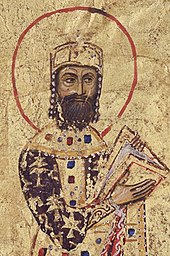Battle of Kalavrye
| Battle of Kalavrye | |||||||
|---|---|---|---|---|---|---|---|
 Miniature of Alexios Komnenos, the victor of Kalavrye, as emperor |
|||||||
|
|||||||
| Belligerents | |||||||
| Imperial forces of Nikephoros III Botaneiates | Rebel forces of Nikephoros Bryennios the Elder | ||||||
| Commanders and leaders | |||||||
| Alexios Komnenos | Nikephoros Bryennios (POW) | ||||||
| Strength | |||||||
| 5,500–6,500 (Haldon) 8,000–10,000 (Birkenmeier) |
12,000 | ||||||
| Casualties and losses | |||||||
| Heavy | Heavy | ||||||
The Battle of Kalavrye (also Kalavryai or Kalavryta) was fought in 1078 between the Byzantine imperial forces of general (and future emperor) Alexios Komnenos and the rebellious governor of Dyrrhachium, Nikephoros Bryennios the Elder. Bryennios had rebelled against Michael VII Doukas (r. 1071–78) and had won over the allegiance of the Byzantine army's regular regiments in the Balkans. Even after Doukas's overthrow by Nikephoros III Botaneiates (r. 1078–81), Bryennios continued his revolt, and threatened Constantinople. After failed negotiations, Botaneiates sent the young general Alexios Komnenos with whatever forces he could gather to confront him.
The two armies clashed at Kalavrye on the Halmyros river in what is now European Turkey. Alexios Komnenos, whose army was considerably smaller and far less experienced, tried to ambush Bryennios's army. The ambush failed, and the wings of his own army were driven back by the rebels. Alexios barely managed to break through with his personal retinue, but succeeded in regrouping his scattered men. At the same time, and despite having seemingly won the battle, Bryennios's army fell into disorder after its own Pecheneg allies attacked its camp. Reinforced by Turkish mercenaries, Alexios lured the troops of Bryennios into another ambush through a feigned retreat. The rebel army broke and Bryennios was captured.
The battle is known through two detailed accounts, Anna Komnene's Alexiad, and her husband Nikephoros Bryennios the Younger's Material for History, on which Anna's own account relies to a large degree. It is one of the few Byzantine battles described in detail, and hence a valuable source for studying the tactics of the Byzantine army of the late 11th century.
...
Wikipedia
